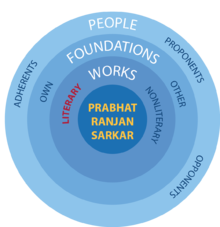User:Sharala/sandbox: Difference between revisions
No edit summary |
No edit summary |
||
| Line 1: | Line 1: | ||
{{Infobox discourse | {{Infobox discourse | ||
| title = <!-- Write the name of the title --> | | title = <!-- Write the name of the title -->Svábhávika Dharma and Bhágavata Dharma | ||
| image = <!--Write image name eg. Example.jpg, do not include "File:" --> | | image = <!--Write image name eg. Example.jpg, do not include "File:" --> | ||
| caption = | | caption = | ||
| Line 14: | Line 14: | ||
| included in = [[Ananda Vacanamrtam Part 33]] | | included in = [[Ananda Vacanamrtam Part 33]] | ||
}} | }} | ||
''''' | '''''Svábhávika Dharma and Bhágavata Dharma''''' is a discourse given by [[Shrii Shrii Anandamurti]] on 1964 December 9 in Salem, India. This discourse is the first chapter of [[Ananda Vacanamrtam Part 33]].<ref name="AV33">{{cite book|title=Ananda Vacanamrtam Part 33|author=Shrii Shrii Anandamurti}}</ref> | ||
== Synopsis == | == Synopsis == | ||
{{Quote box|width=360px|bgcolor=|align=left|quoted=1|salign=right|quote= | {{Quote box|width=360px|bgcolor=|align=left|quoted=1|salign=right|quote=The object of both, svábhávika dharma and Bhágavata dharma, is the same: to get sukham [pleasure]. But in svábhávika dharma the intensity of sukham is limited, while in Bhágavata dharma it is beyond any measure, it is ananta. As a man thinks, Nálpe sukhamasti Bhúmaeva sukham [“One does not get infinite happiness from limited objects; one gets it only from something infinite”]. One can be satisfied with Bhágavata dharma alone.|source=Shrii Shrii Anandamurti}} | ||
Anandamurti starts the discourse by saying that Dharma can be separated into two categories: ''svábhávika dharma'' (pertaining to the sustenance of the body) and Bhágavata dharma (longing for infinite happiness). Human beings are different from animals in their ability to achieve unlimited happiness (''ananta''). Anandamurti then explains that ''Bhágavata dharma'' consists of four elements: ''Paramátmá'' (this quality is only attributed to the Supreme Consciousness) ), ''vistára'' (expansion), ''rasa'' (cosmic flow) and ''sevá'' (service). Anandamurti goes on saying that service is of two types: external service (physical, martial, economic and intellectual service) and internal service (directing the mind toward the Supreme goal in meditation).<ref name="AV33"/> | Anandamurti starts the discourse by saying that Dharma can be separated into two categories: ''svábhávika dharma'' (pertaining to the sustenance of the body) and Bhágavata dharma (longing for infinite happiness). Human beings are different from animals in their ability to achieve unlimited happiness (''ananta''). Anandamurti then explains that ''Bhágavata dharma'' consists of four elements: ''Paramátmá'' (this quality is only attributed to the Supreme Consciousness) ), ''vistára'' (expansion), ''rasa'' (cosmic flow) and ''sevá'' (service). Anandamurti goes on saying that service is of two types: external service (physical, martial, economic and intellectual service) and internal service (directing the mind toward the Supreme goal in meditation).<ref name="AV33"/> | ||
== References == | == References == | ||
| Line 28: | Line 28: | ||
| title = [[Ananda Vacanamrtam Part 33]] | | title = [[Ananda Vacanamrtam Part 33]] | ||
| years = 1978 | | years = 1978 | ||
| with = | | with = Svábhávika Dharma and Bhágavata Dharma | ||
| before = ''[[Brahma Cakra]]'' | | before = ''[[Brahma Cakra]]'' | ||
| after = ''[[Svabhavika Dharma and Bhagavata Dharma|Svábhávika Dharma and Bhágavata Dharma]]'' | | after = ''[[Svabhavika Dharma and Bhagavata Dharma|Svábhávika Dharma and Bhágavata Dharma]]'' | ||
Revision as of 09:46, 14 April 2020
| Svábhávika Dharma and Bhágavata Dharma | |
|---|---|
| Speaker | Shrii Shrii Anandamurti |
| Date | 1965 November 20 |
| Place | Ernakulam, India |
| Topic | How to get closer to God |
| Included in | Ananda Vacanamrtam Part 33 |
| Location in Sarkarverse | |
Svábhávika Dharma and Bhágavata Dharma is a discourse given by Shrii Shrii Anandamurti on 1964 December 9 in Salem, India. This discourse is the first chapter of Ananda Vacanamrtam Part 33.[1]
Synopsis
The object of both, svábhávika dharma and Bhágavata dharma, is the same: to get sukham [pleasure]. But in svábhávika dharma the intensity of sukham is limited, while in Bhágavata dharma it is beyond any measure, it is ananta. As a man thinks, Nálpe sukhamasti Bhúmaeva sukham [“One does not get infinite happiness from limited objects; one gets it only from something infinite”]. One can be satisfied with Bhágavata dharma alone.
Anandamurti starts the discourse by saying that Dharma can be separated into two categories: svábhávika dharma (pertaining to the sustenance of the body) and Bhágavata dharma (longing for infinite happiness). Human beings are different from animals in their ability to achieve unlimited happiness (ananta). Anandamurti then explains that Bhágavata dharma consists of four elements: Paramátmá (this quality is only attributed to the Supreme Consciousness) ), vistára (expansion), rasa (cosmic flow) and sevá (service). Anandamurti goes on saying that service is of two types: external service (physical, martial, economic and intellectual service) and internal service (directing the mind toward the Supreme goal in meditation).[1]
References
| Preceded by Brahma Cakra |
Ananda Vacanamrtam Part 33 1978 With: Svábhávika Dharma and Bhágavata Dharma |
Succeeded by Svábhávika Dharma and Bhágavata Dharma |
